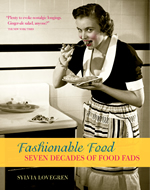Let Them Eat Cake
A Betty Crocker booklet called the Twenties “the beginning of the real cake era.” In looking at the cookbooks from the period you begin to see what was meant. There are spice cakes, angel cakes, devil cakes, sponge cakes, and fudge cakes. There were date cakes, nut cakes, prune cakes, and jam cakes. There were pound cakes, fairy cakes, buttermilk cakes, chocolate cakes, eggless cakes, burnt-sugar cakes, mocha cakes, sunshine cakes, maple cakes, marble cakes, and checkerboard cakes. These lush creations were stuffed, gilded, and embellished with luscious frostings, fillings, and icings opulently flavored with chocolate, coconut, marshmallow, lemon, orange, whipped cream, mocha, caramel, pineapple, maple, maraschino, and brown sugar.
Part of the reason for cake’s newfound popularity was that, in those recently maidless and hurry-up days, it became fashionable to have only one dish for the dessert course. Pictorial Review’s April 1928 issue assured the worried hostess that her cake could be made as tall and imposing as she wished, and that by “adding story upon story to her confection … everyone who beholds it will be convinced that such a cake only, is sufficient for the complete course.”
Certainly one of the most imposing cakes was the Lady Baltimore. Although this cake of Charleston, South Carolina, origin was first made in the late 1800s, it was immensely popular in the Twenties. More confection than cake, rich with butter and eggs, stuffed with nuts and fruits, and topped with a devastatingly sweet meringue frosting, Lady Baltimore was perfect Ladies’ Luncheon food—and perfectly delicious.
There are as many variations of Lady Baltimore cake as there are cooks. The following one, however, is from Alicia Rhett Mayberry, a great lady of Charleston who is usually conceded to have introduced the cake. Mrs. Mayberry’s recipe is made with two separate fillings and contains no figs or rose water, common additions in other recipes.
Lady Baltimore Cake
Although the original recipe says this will make three layers, I found it to be a two-layer, plus one very large cupcake, cake. Two layers will not make a cake as ineffably high as the standard Lady Baltimore. On the other hand, the fillings in this recipe are so achingly sweet and rich—more like divinity fudge than frosting—that two layers are already overkill. Reserve this cake only for those with a real sweet tooth.
For the Cake
½ cup (1 stick) butter
1½ cups sugar
2 large eggs, separated
2 cups cake flour
1 teaspoon baking powder
½ teaspoon salt
1 cup milk
For Filling I
1 cup sugar
½ cup walnut meats
¼ cup water
1 teaspoon vanilla extract
1 teaspoon almond extract
For Filling II and Assembly
2 cups sugar
½ cup water
2 large egg whites, beaten until stiff but not dry
1 teaspoon vanilla extract
1 teaspoon almond extract
1 cup chopped raisins
1 cup chopped walnuts
Juice of ½ lemon
Preheat the oven to 375°F. Butter two 8-inch layer cake pans and 2 medium muffin cups. To make the cake, cream the butter and sugar together until light. Beat the egg yolks until light, then beat them into the butter mixture. Sift the dry ingredients together three times. Fold the dry ingredients into the butter mixture alternately with the milk, ending with the flour mixture. Beat the egg whites until stiff but not dry. Fold the whites into the batter. Spoon the batter into the cake and muffin cups and bake until they test done, about 25 minutes. Take out of the oven and let rest in the pans 10 minutes. Remove from the pans and cool on a wire rack. When cool, set the cupcakes aside for another use; fill and frost the cake layers as described below.
While the cakes are baking, make the fillings. For Filling I, put the sugar, walnuts, and water in a small saucepan and cook over medium heat without stirring to the very soft ball stage (232°F on a candy thermometer) when a spoonful of syrup dropped into a cup of ice water forms thick threads. Remove from the heat and let cool to 110°F. Stir in the extracts, then beat until slightly thickened. Set aside until the cake layers are cool. Spread half of Filling I over each cake layer.
For Filling II, dissolve the sugar in the water in a heavy saucepan. Do not stir after this point. Bring to a boil over medium heat. Cover and boil for 3 minutes. Remove the cover and boil over medium-low heat until the mixture reaches the firm ball stage (246°F on a candy thermometer) when a spoonful of the syrup dropped into a cup of ice water forms a ball that holds its shape unless pressed with a finger. Pour the hot syrup slowly into the beaten egg whites, beating constantly. (Be sure to add slowly or you will end up with very nasty, sticky nuggets of cooked egg.) Continue beating until cool. Quickly add the extracts, raisins, nuts, and lemon juice. Set aside until the cake layers are cooled. Spread a little of Filling II over Filling I on each layer. Stack one layer on top of the other, filling sides up. Frost the sides with the rest of Filling II.
Makes 1 cake and 2 cupcakes
